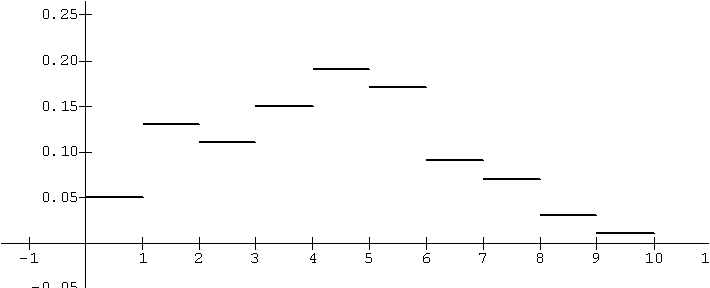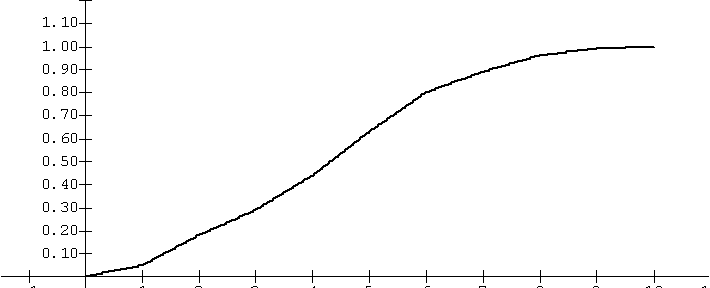[The Dart Model] Suppose you are
throwing a dart at a region in the plane and measuring a random variable
X determined by the position of the dart. X has values only between 0 and
10. Unfortunately you are not given the distribution function of X. [Recall
that for any real number A between 0 and 10 the distribution function F,
would give you F(A), the probability that the value of X is less than or
equal to A.]
Instead you have been given a graph, an algebraic expression and a
table for the probability density function of X. [Recall that for
any real number A between 0 and 10 the probability density function
of X, f, gives you f(A), the derivative of F at A,
which is approximately the ratio of the probability of the random variable
X being in an interval [A, A+h] to the length of that interval,
h.]
Based on this information do you think you could estimate the probability
that the value of X being less 5? Recognizing that F(0) = 0 and F(10) =
1, could you estimate F(A) for any A between 0 and 10? As a practical matter,
you might break the interval into10 pieces of equal length and then estimate
the probability of X being in each of those interval from the density of
X at some point in that interval. Then for A, just add up the probability
estimates for X being in an interval that has values less than or equal
to A. |
| A |
f (A) |
| 0.5 |
.05 |
| 1.5 |
.13 |
| 2.5 |
.11 |
| 3.5 |
.15 |
| 4.5 |
.19 |
| 5.5 |
.17 |
| 6.5 |
.09 |
| 7.5 |
.07 |
| 8.5 |
.03 |
| 9.5 |
.01 |
|
 Graph of data for f(A)
The Probability Density Function for X
Graph of data for f(A)
The Probability Density Function for X
|
|
Solution: As suggested, consider
the interval [0,10] broken into smaller intervals each of length 1, i.e.,
[0,1], [1,2], [2,3], ... , [8,9], and [9,10]. Since each of these intervals
has length 1, we can use f (A) as an estimate for the probability
of the dart falling in the inteval that contains A. So, for example we
estimate the probability that X lies in the interval [0,1] with f
(.5) = .05, while we estimate the probability that X lies in the interval
[1,2] with f (1.5) = .13. Continuing in this fashion we make estimates
of the probability of X being in each of the ten intervals.
Now use these to estimate the probability that X is less than 5 by accumulating
the probabilities of the intervals that would have X less than 5. Thus
we estimate
F(5) = Prob( X<5) = 0.05 + 0.13 + 0.11 + 0.15 + 0.19 =
0.64 .
The distribution function might be estimated by assuming the density is
uniform for each of the ten intervals. So, for example, if 0<A<1
then F(A) = 0.05 A, while if 1<A<2 then F(A) = 0.05 + 0.13(A-1).
Following this pattern if 9<A<10 then F(A) = 0.99 + .01(A-9).
One way to visualize this example is to use the density function value
for the height of a rectangle with a unit base. Then the region in the
plane above the interval [0,10} has a total area of one square unit. Assuming
the distribution is uniform for each interval allows us to see the probability
that X < A as the area of the region above the X axis and bounded by
the vertical lines, X = 0 and X = A. |
Estimated probabilities that X is in
an interval based on the given probability densities
| interval |
Estimated probability |
|
[0,1]
|
.05
|
|
[1,2]
|
.13
|
|
[2,3]
|
.11
|
|
[3,4]
|
.15
|
|
[4,5]
|
.19
|
|
[5,6]
|
.17
|
|
[6,7]
|
.09
|
|
[7,8]
|
.07
|
|
[8,9]
|
.03
|
|
[9,10]
|
.01
|

|
Estimated probability distribution function
based on the given probability densities
| A in the interval |
F(A)
|
|
[0,1]
|
.05 A
|
|
[1,2]
|
.05 +.13 (A - 1)
|
|
[2,3]
|
0.18 + .11 (A - 2)
|
|
[3,4]
|
0.29 + .15 (A - 3)
|
|
[4,5]
|
0.44 + .19 (A - 4)
|
|
[5,6]
|
0.63 + .17 (A - 5)
|
|
[6,7]
|
0.80 + .09 (A - 6)
|
|
[7,8]
|
0.89 + .07 (A - 7)
|
|
[8,9]
|
0.96 + .03 (A - 8)
|
|
[9,10]
|
0.99 + .01 (A - 9)
|
 Graph of Estimated
Probability Distribution Function for
X
based on the given probability densities
Graph of Estimated
Probability Distribution Function for
X
based on the given probability densities
|